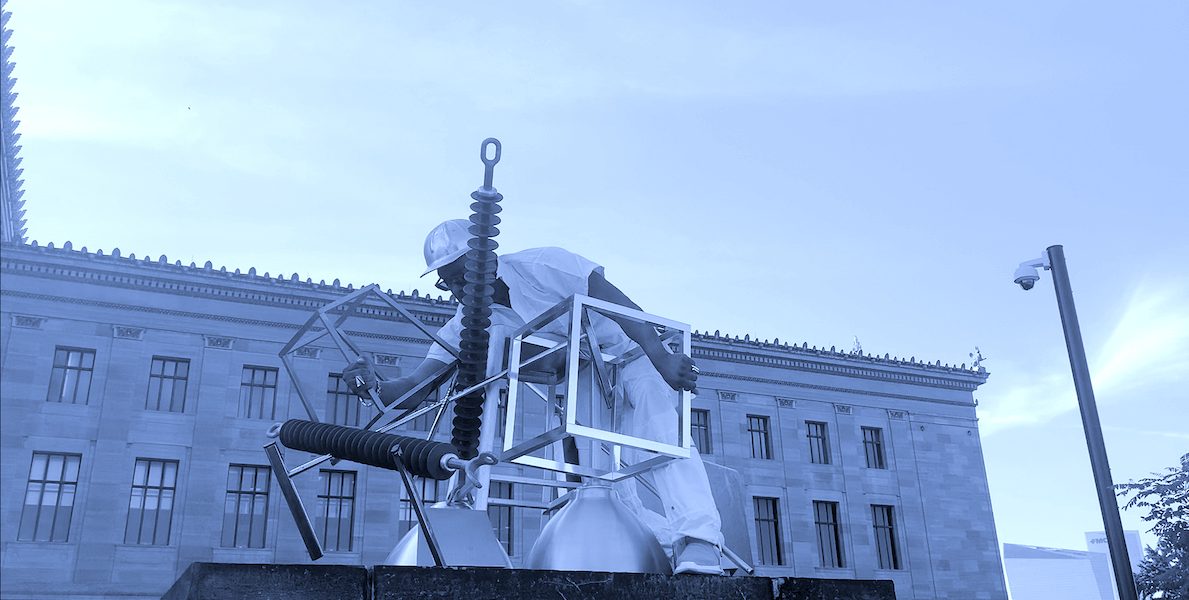When I conduct interviews for Art For Change, I typically speak with my guest via Zoom and transcribe the conversation afterwards. How do the guests normally look on my screen? It doesn’t usually matter. However, I would be remiss not to share how multidisciplinary artist Taji Ra’oof Nahl looked during our conversation: Decked out in a black suit and a custom white dress shirt, Nahl elegantly reclined against a white modern chair and spoke to me from behind dark sunglasses. He shared that he was in his studio space in West Mt Airy. Leaning against his chair was a notably large monitor that displayed a playlist of videos from his YouTube channel.
This elaborate setup won’t surprise anyone who is familiar with the 62-year-old multidisciplinary artist, musician and cultural provocateur. Nahl is known for his expansive approaches to both art and life. For decades, he has worn many hats in Philadelphia’s art scene: gallerist, artist, filmmaker, fashion designer, historian, performer — just to name a few. Before that, he made a living selling second-hand clothing and goods through various flea markets. Nahl refers to himself as a “third generation thrift shopper” and credits his grandmother for teaching him the tactile art of finding quality clothing.
Nahl recently conducted an experimental performance at The Rotunda as part of an ongoing residency. Up next: an experimental, musical performance with frequent collaborator John Schlesinger on Saturday October 21 for Philadelphia Open Studio Tours. Performances will occur at 1 and 4pm at Schlesinger’s studio in Powelton Village.
Over the years, Nahl has kept grounded through a deep sense of gratitude and a keen sense of style. With both in hand, he is able to continue experimentations that further his own vision, one that primarily deals with the legacy of Black excellence. Although he is grateful for the recognition his work is finally starting to receive from major institutions, Nahl is comfortable with the ambiguity of success. “I’m enjoying the ride,” he explains, “and my work is going to be my work, regardless.”
As part of a partnership with Forman Arts Initiative, The Citizen caught up with Taji Ra’oof Nahl. This interview has been condensed and edited for clarity.
Logan Cryer: That is a great studio space. Is your studio in your house?
Taji Ra’oof Nahl: I have a duplex in West Mt. Airy. Downstairs is the living quarters, and the second floor is the studio.
How long have you been there?
Living, going on 20 years. As a studio, about 14 years.
How long have you lived in Philly?
It’s a tale of two cities, basically. Originally born and raised in Philadelphia, and then, in the middle of my teenage years, moved to Camden, New Jersey. After I got married I moved to South Jersey. We moved back here around about ’89 or ’90.
Tell me about your early work experience.
I worked in the prison system as an Islamic chaplain. Starting out when I was 17, I was going to prisons with elders and learning the ropes until I was about 20. Then I started going on my own and did that until I was about 37. I got tired of that because of the recidivism. It was like a revolving door, I would see guys be in for four years, leave, and then be back the next year.
The final straw was that I had two cousins who were inmates at Riverfront prison [in Camden] where I was a chaplain. I said, This is crazy how it’s three people from my family in this prison, and only one of us can leave when they’re ready. When I saw my two cousins behind bars I thought, That’s enough for me.
Were you making art during all that time?
No. I like to say I’m a late bloomer. I didn’t start as a practitioner until I was 50 years old.
What made you get started?
Well, that was a crazy transition. I had my own art gallery, Taji Modern Gallery, back in the late 90s, early 2000s, up to about 2009. Then I closed down, because of the crash of 2008.
From there, I started working from my home, making all my connections, and using the classic Rolodex, trying to figure out what my next move was. In the process of that, I started doing repurposed clothing. I had all this vintage clothing that was my personal collection, so I’d be taking things apart, putting them back together. I actually had a fashion brand called Animated Man. Doing the fashion is, Okay, I make this jacket, or I make this shirt, or these pants. I couldn’t just put it on. I had to put a model in it, and have them do something. I was very much influenced by the great artist Man Ray, where I put a prop next to a person, or whatever, like that.
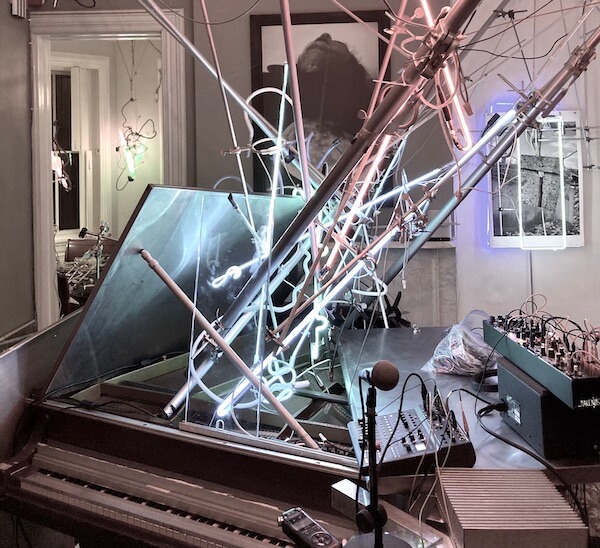
Then I started studying fashion films. So I started filming my work that had to have a narrative to it, some type of storyline. There, the storylines took off, and the fashion became less important for me. I created this whole world around the clothing. In the midst of all of that, I was showcasing Philadelphia, meaning, I would go around to different places: Old City, South Philly, North Philly, West Philly, the suburbs, and I would have the garments in these environments, to help tell the different stories.
From there, I got into the subcultures of Philadelphia: people who were cyclists, skateboarders, dancers, hardcore. The list goes on and on. I had all these different people, with all these different professions and things that they like to do. I said, “My brand name was called Animated Man. Whatever you like to do, you can do it in my garments.” That is the nexus of what my work is right now. Everything I’m doing right now just spawned from that.
What shifted for you where it started to feel more personally fulfilling?
The shift was creating the narrative and the storylines around the garments. One example from that time period was called Defenders of the Republic. In a republic, you have four main entities. We have economics, education, culture, and government. All communities are based off of these four principles. From that, I had these figures, and I had models. One had a telephone, and he was the communications guy. Then another person, he had a stack of books. He was into the education. Another person, he was the government. So he’s looking like he’s doing security work for some senator or whatever. Defenders of the Republic is still going on currently. That’s still a part of my work.
Was art-making something that was bubbling up for you throughout your life?
My wife was just telling me the other day how she was noticing all these actors and actresses who are painters and sculptures now, and it’s a long trend of people who finish their profession, retire, and they’re going through their senior years, and children have grown. I’m fortunate. The children are grown and I have this great space, and I just utilize all my assets. I have stories of how I used to show videos when I was nine, 10 years old. I had this toy video projector and I used to invite my friends and cousins over, and I had my little sisters, and we would go to the top of our two-story house, and close all the doors. It’d be three in the afternoon and I would have the movies going. So we talk about, almost 60 years later, I’m still showing movies.
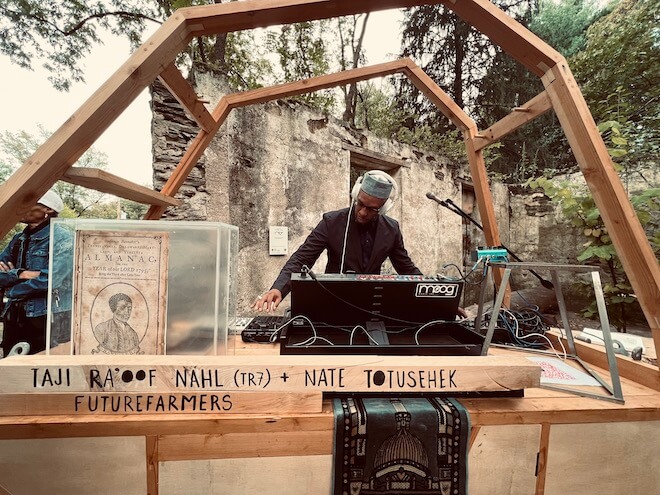
Are there artists or others in the Philadelphia creative field who inspired you?
Brian Bazemore, Betty Leacraft. We had one who just passed, Leroy Johnson. I met Leroy at some art show, something that he was exhibiting somewhere, and we ran across each other. Leroy, he was a champion of my work. I championed his work. We were in the process of working on a project together. I had this collective called Two Spiral, a loose collective of Philadelphian artists, who just get together to support each other’s work, and Leroy was one of those. I was going to put an exhibition around the idea of the original Spiral Collective. I felt really void when he passed.
Can you talk a little bit about your latest performance at The Rotunda?
The Rotunda is a performance art space, and as such, they allow me to come in and do what I like to do. It was a pop-up installation of performance video work. I’ve done three iterations so far. One was one of my concepts called Renaissance Report Live. I used the format of the late-night TV show, like Johnny Carson, but everything is about art. The person that’s playing the host, they come out, they do their monologue, which has to be around art. Then, the banter between the host and the band, I have that scenario, as well. And then, all the skits have to be art-related. The people that are interviewed also are artists. So this is a platform to showcase other artists.
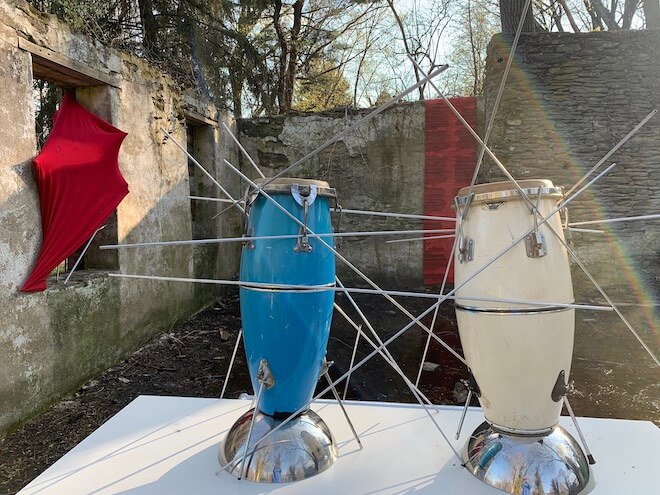
Also, I’ve done a micro film festival. The space is totally covered with video projections, in that there’s, the second component is the live soundtrack scoring session, where the musicians, along with myself, score the videos live.
Recently, I’ve been dealing with Benjamin Banneker as an astronomer, as a mathematician, as a person who did a treatise on bees. He was one of the first to talk about the importance of bees in the ecological system; he wrote about it in his almanac. The latest iteration at The Rotunda is called Calculating Banneker: Harvest. This project is around harvesting honey from the bees, because I’m also doing a residency currently with the Philadelphia Beekeepers Guild at Awbury Arboretum. So these two residencies have coincided for the last two years.
What’s a perspective that you’ve gained on life that you want to put out there into the world?
I’m a man who lives by principles, and that is embedded in my work. If people were more genuine, were more sincere, and more open-minded, we could get through a lot of the issues that we have with each other. There’s a lot of people that don’t mean you no good, and you got to constantly keep those type of people at bay. But at the same time, you got to keep on moving. One of my favorite words is “possibilities.” I’m grateful for the life that I have. God has been very merciful to me, and I like to share that blessing that God has given me to others.
Logan Cryer is a curator based in Philadelphia with a penchant for local art histories. They currently serve as the Co-Curator of Icebox Project Space and they like to rewatch documentaries.
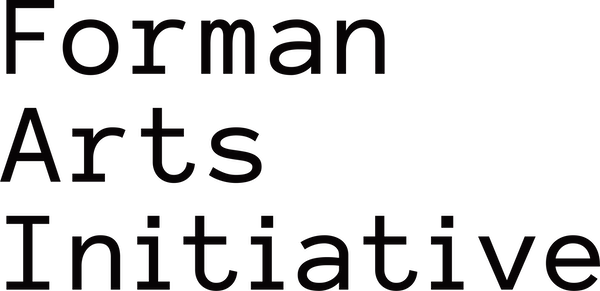 This story is part of a partnership between The Philadelphia Citizen and Forman Arts Initiative to highlight creatives in every neighborhood in Philadelphia. It will run on both The Citizen and FAI’s websites.
This story is part of a partnership between The Philadelphia Citizen and Forman Arts Initiative to highlight creatives in every neighborhood in Philadelphia. It will run on both The Citizen and FAI’s websites.
![]() MORE FROM OUR ART FOR CHANGE SERIES
MORE FROM OUR ART FOR CHANGE SERIES



